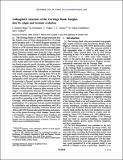Por favor, use este identificador para citar o enlazar a este item:
http://hdl.handle.net/10261/42675COMPARTIR / EXPORTAR:
 SHARE SHARE
 CORE
BASE CORE
BASE
|
|
| Visualizar otros formatos: MARC | Dublin Core | RDF | ORE | MODS | METS | DIDL | DATACITE | |

| Título: | Lithospheric structure of the Gorringe Bank: Insights into its origin and tectonic evolution |
Autor: | Jimenez-Munt, Ivone CSIC ORCID ; Fernández Ortiga, Manel CSIC ORCID ; Vergés, Jaume CSIC ORCID ; Afonso, Juan Carlos CSIC ORCID; García-Castellanos, Daniel CSIC ORCID ; Fullea, J. CSIC ORCID | Palabras clave: | Potential fields Gabbros Serpentinized peridotites |
Fecha de publicación: | oct-2010 | Editor: | American Geophysical Union | Citación: | Tectonics (29) : TC5019 (2010) | Resumen: | The Gorringe Bank is a 5000 m high seamount near the Atlantic coast of Iberia characterized by a 9 m high geoid anomaly and a ~120 mGal Bouguer anomaly relative to the surrounding abyssal plains. It has been linked to a NW directed thrust carrying exhumed upper mantle rocks and transitional crust on top of flexed-down Eurasian oceanic crust along the Tagus Abyssal Plain. However, estimations of crustal shortening have yielded dissimilar results, and the deep structure of the ridge remains highly unknown. We present a restored cross section and a new model of the lithospheric structure based on gravity, geoid, elevation, and the presence of serpentinized peridotites. At least 20 km of shortening took place along a flat-ramp-flat thrust fault, and the density structure of the lithosphere is consistent with mantle serpentinization varying from 70% at the surface to 20% at 14 km depth and 0% at 40 km. The topographic relief and gravity anomalies are explained by assuming a flexural isostatic model with an elastic thickness Te of ~30 km. The evolution of the Gorringe Bank since the Late Jurassic is interpreted in relation to Eurasia-Africa-North America plate motion in four stages: (1) transtension between Newfoundland-Iberia and Africa, which generated small oceanic basins and mantle exhumation; (2) opening of the North Atlantic and seafloor spreading at the NW side of the exhumed Gorringe, which produced gabbro intrusions and serpentinization; (3) a quiescent tectonic period dominated by subsidence and sediment accumulation; and (4) a transpressional plate boundary between Eurasia and Africa with NW directed subcrustal thrusting and generation of the present Gorringe relief. | Versión del editor: | http://www.agu.org/journals/tc/tc1005/2009TC002458/ | URI: | 10261/42675 | DOI: | 10.1029/2009TC002458 | ISSN: | 0278-7407 | E-ISSN: | 1944-9194 |
| Aparece en las colecciones: | (Geo3Bcn) Artículos |
Ficheros en este ítem:
| Fichero | Descripción | Tamaño | Formato | |
|---|---|---|---|---|
| Jimenez-Munt_etal._Tectonics2010-Gorringe.pdf | 7,19 MB | Adobe PDF |  Visualizar/Abrir |
CORE Recommender
SCOPUSTM
Citations
54
checked on 21-abr-2024
WEB OF SCIENCETM
Citations
50
checked on 27-feb-2024
Page view(s)
288
checked on 27-abr-2024
Download(s)
231
checked on 27-abr-2024
Google ScholarTM
Check
Altmetric
Altmetric
NOTA: Los ítems de Digital.CSIC están protegidos por copyright, con todos los derechos reservados, a menos que se indique lo contrario.
